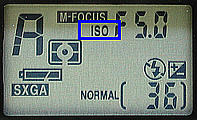
|
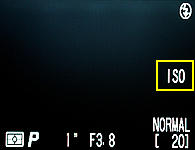
|
Here, sensitivity means the sensitivity of the image capturing device of the 995. The more sensitive this device is, the less light is required to form an image. The sensitivity is calibrated based on the ISO rating (International Organization for Standardization). According to Nikon, this CCD is rated equivalent to ISO 100, which is the default sensitivity.
In A-REC, the setting of sensitivity is fully automatic, which means a user has no way to change the sensitivity of the CCD. On the other hand, in M-REC, one can either stay with the fully automatic mode, or set the sensitivity to 100, 200, 400 or 800. Setting the sensitivity to 200 means that the CCD is twice more sensitive to the light than that of 100. Thus, only 50% of the light originally for 100 is needed. For example, suppose under sensitivity 100 aperture F5.6 and shutter speed 1/125 second are required to have a good exposure. Setting sensitivity to 200, we can either keep the aperture at F5.6 and half the shutter speed (i.e., changing 1/125 second to 1/500 second), or keep the shutter speed at 1/125 second and reduce the aperture to F8.0. If the sensitivity is raised to 400 (i.e., four times more sensitive than that of ISO 100), the same set of aperture and shutter speed (i.e., F5.6 and 1/125 second) can be changed to F11.0 and 1/125 second, F8.0 and 1/500 second, and F5.6 and 1/1000 second. There are certainly other equivalent (aperture, shutter speed) combinations, and the above only suggests a set of possibilities. Therefore, raising sensitivity allows us to use faster shutter speed or smaller aperture. See shutter-priority and aperture-priority for the advantages of using faster shutter speed and smaller aperture, respectively. Moreover, in low light condition, setting sensitivity to a higher value can also help maintain a reasonable shutter speed.
However, using a sensitivity value other than 100 may cause a slight amount of noise to appear in images.
As mentioned earlier, there is no control over sensitivity in A-REC. When the exposure system detects that lighting is insufficient for the current image, the camera will automatically increase the sensitivity to accommodate the situation. Should this happen, the control panel and LCD monitor will display ISO as shown below.

|

|
Turning the mode dial to A-REC resets sensitivity to the default value.
The sensitivity value can be changed in M-REC. There are five choices:
| Setting | Meaning |
| 100 | This is the default value. |
| 200 | It is equivalent to ISO 200, and, therefore, is twice more sensitive than ISO 100. |
| 400 | It is equivalent to ISO 400, and, therefore, is twice (resp., four times) more sensitive than ISO 200 (resp., ISO 100). |
| 800 | It is equivalent to ISO 800, and, therefore, is four (resp., eight times) more sensitive than ISO 200 (resp., ISO 100). |
| AUTO | This is equivalent to ISO 100 under normal conditions. However, when lighting is poor, the camera will automatically increase the sensitivity value to compensate. The word ISO appears on both the control panel and LCD monitor. |
To select a sensitivity value, hold the flash setting button (below left) and at the same time turn the command dial (below right).
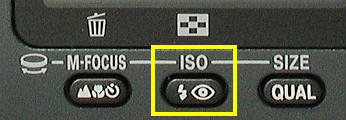
|
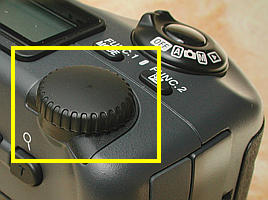
|
| The Flash Setting button | The Command Dial |
While turning the command dial, the following sensitivity values appear on both the control panel and LCD monitor. Note that the order of this value is not cyclic. Thus, once AUTO is reached, the command dial has to be turned in the opposite direction to go back to 400, 200 and 100. That is, the values do not wrap-around.

While turning the command dial, possible settings as shown above are displayed on both the control panel and LCD monitor:
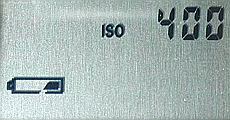
|
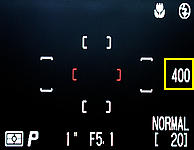
|
| ISO 400: control panel | ISO 400: LCD monitor |
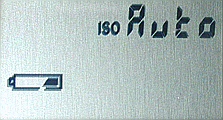
|
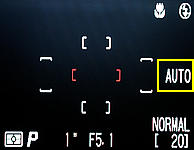
|
| ISO AUTO: control panel | ISO AUTO: LCD monitor |
Except for AUTO, the selected sensitivity value and the word ISO stay on the LCD monitor and control panel. In the case of AUTO, there is no ISO on the control panel and AUTO only appears on the LCD monitor briefly. However, once the camera detects low light condition and the sensitivity has to be increased to compensate, the word ISO will appear on both control panel and LCD monitor. Moreover, when the sensitivity is set to ISO 800, the image recorded will be quite noisy and the ISO value displayed on the monitor is shown in red as shown below.
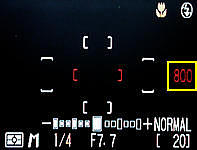
|
| ISO 800: LCD monitor |
Note that you cannot change sensitivity in A-REC, and that the sensitivity set in M-REC will stay even though the camera is turned off. Therefore, it has to be reset explicitly.